Since the Mahi Mahi has such a unique appearance, it seems to have no teeth. However, the fact is that the Mahi Mahi do have teeth, and it is a myth that they do not. Therefore, it is not safe to put your hand in this fish’s mouth.
Mahi Mahi is called the “jewel of the ocean” because of its unique appearance and properties. If you are an angler or simply a fish lover, this is a great fish to get to know. The teeth of a Mahi Mahi are relatively small and needle-like, like those found in other pelagic species such as tuna and wahoo. These teeth are primarily used to grasp prey such as squid, small fish, and crustaceans. Despite their size, Mahi’s teeth can still cause injury if an angler mishandles the fish during landing or removal from the hook. While not particularly dangerous to humans, it’s still important to exercise caution when handling fish with teeth.
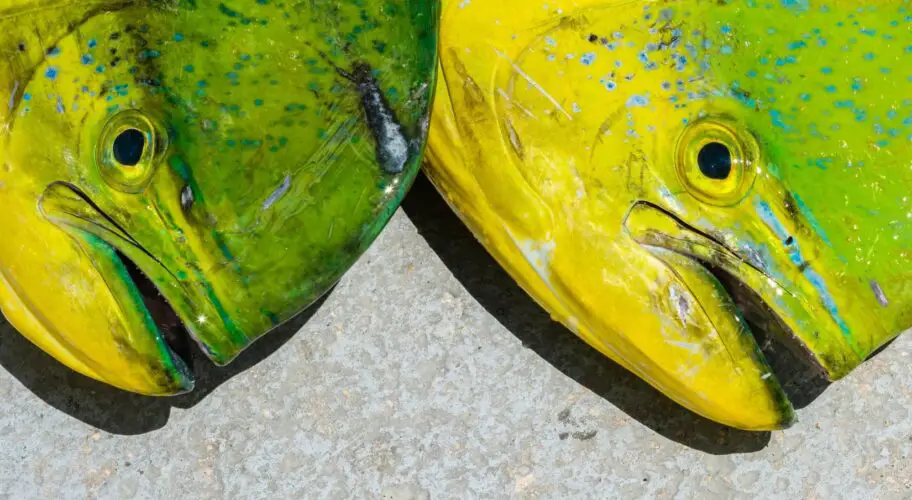
Does Mahi Mahi have Teeth in their Jaw?
As mentioned above, it is just a misconception that the Mahi Mahi does not have teeth because it does. The fish has a large mouth and if you look closely, you will find very sharp, tiny teeth around the jaw.
There are four main types of teeth found in fish:
- Canines
- Molars
- Incisors
- Fused into plates
For Mahi Mahi, they have the typical canines, which are the sharpest teeth. All these teeth serve the same purpose and vary in how they operate and how useful they are in catching prey. Canines are predatory fish, as they help tear apart their prey. The other types of teeth are present in omnivorous and herbivorous fish, as this helps grind food and break it apart, but it is not as effective.
Since Mahi Mahi have canines, they are experts in tearing apart any fish in front of them. One should never try to take this fish lightly. This fish is known to be a fighter and very hard to catch.
Are Mahi Mahi Teeth Visible?
Mahi Mahi, like most fish have teeth that are relatively small and not particularly visible unless you examine them closely. Their teeth are located in their jaws and are used for grasping and holding onto prey. While Mahi Mahi’s teeth are not particularly prominent, they are sharp enough to inflict a painful bite if handled carelessly. When preparing Mahi Mahi for cooking or eating, it’s important to be aware of their teeth and handle them carefully to avoid injury.
Functional Uses of Mahi Mahi Teeth
Like most fish, Mahi has teeth primarily used for catching and holding onto prey. Mahi Mahi has small, sharp teeth in their jaws, allowing them to grab and swallow smaller fish, squid, and prey.
In addition to their primary function in feeding, Mahi Mahi’s teeth may also attract mates during the breeding season. Some studies suggest that male Mahi Mahi may use their teeth as a secondary sexual characteristic, displaying them to females as a sign of strength and dominance. Overall, the functional uses of Mahi Mahi’s teeth are primarily related to feeding and reproduction, which are essential for the survival and continuation of the species.
Why does Mahi Mahi have teeth?
Their teeth are very sharp and perfect for attacking prey when necessary or defending themselves. The Mahi Mahi need teeth if they want to survive in the ocean, and they are mainly used for food. Here are the uses of their powerful teeth for living in the ocean.
To defend themselves
For anglers, Mahi Mahi is a possession that does not come easily. Only experts are able to catch this fish because it is very feisty. This, along with its size, explains why the fish is around 15 to 30 pounds and reaches a maximum size of about 1 meter, with the female fish being a little smaller.
With this, one can assume that they put up a great fight in the ocean in front of any predators. Even a juvenile Mahi Mahi can put up a fight. This is when their sharp teeth come to use. These teeth help to pierce the skin of the predator to scare it away. Thus, the teeth are very important for Mahi Mahi to defend themselves from various water predators.
They also defend themselves against humans using these teeth and as you know, this fish is very hard to catch. It is a famous recreational fish because people always try to catch this strong fighter. However, their teeth are very sharp, which, combined with their fighting ability, is pretty difficult to do.
To catch prey
A fish is a pretty straightforward creature and has two functions in life, to defend itself and to catch prey. In both cases, both important parts, along with their technique in their teeth. Mahi Mahi has sharp enough teeth to pierce and injure their prey, then eat them.
The fish relies on its fast speed and sharp teeth to capture small fish and other food items. The Mahi Mahi has a large mouth, which also helps it catch prey, and this fish is not afraid to attack larger fish.
The Mahi Mahi is an opportunistic fish that will attack any fish it can find and is not choosy at all. It eats various small fishes, including yellowfin tuna, crustaceans, and other creatures found in the ocean. They use their very strong teeth to eat these creatures, but besides that, these teeth are also very important for digesting food. The prey needs to be broken down into small enough pieces to be digested by their intestine and absorbed into their body.
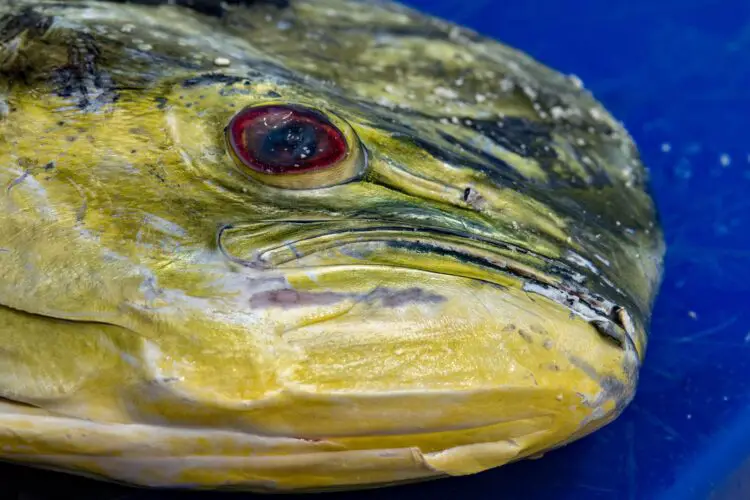
How do Mahi Mahi Eat?
Mahi Mahi is carnivorous fish that feeds by using its sharp teeth and strong jaws to catch and swallow its prey whole. They are opportunistic predators that typically feed on small fish, squid, crustaceans, and other marine invertebrates.
When Mahi Mahi spots a potential meal, they will use their excellent vision to get a good look at the prey. They are known for their speed and agility and often dart quickly toward the prey to capture it. Mahi Mahi has a protruding lower jaw that helps them grasp and hold onto their prey.
Once Mahi Mahi has captured their prey, they will typically swallow it whole. Mahi Mahi has a relatively small esophagus, so they cannot chew their food up enough. Instead, they use their sharp teeth to tear the prey into smaller pieces and then swallow it whole.
Overall, Mahi Mahi are effective and efficient predators that use their speed, agility, and sharp teeth to catch and consume their prey.
Impact of Mahi Mahi Teeth on Fishing
Mahi Mahi’s teeth can have an impact on fishing for them in a few different ways.
First, when targeting Mahi Mahi, it’s important to use appropriate gear and tackle to handle their teeth. Mahi Mahi has small, sharp teeth that can damage fishing lines and potentially cause the fish to escape. Anglers may use wire leaders or heavy fluorocarbon leaders to prevent their line from being bitten through. Additionally, some anglers may use circle hooks to minimize the risk of the hook being swallowed and causing damage to the fish’s throat or stomach.
Second, Mahi Mahi’s teeth can affect the quality of the meat after the fish has been caught. If the teeth have damaged the flesh, it can make the meat less desirable for consumption. To minimize this risk, some anglers may choose to bleed the fish immediately after catching it, which can help to remove any blood or other fluids that could further damage the meat.
Overall, while Mahi Mahi’s teeth can pose some challenges for anglers, they are not typically a major obstacle to catching and handling these fish. With the right gear and techniques, anglers can successfully target Mahi Mahi and enjoy the benefits of their delicious, versatile meat.
What to do with Mahi Mahi’s teeth before cooking?
Before cooking Mahi Mahi, some people choose to remove the teeth entirely to minimize any potential risks when handling or eating the fish if you were going to cook it with the head on. The majority of people will have the head removed and the teeth would not be an issue. Here are some steps you can follow to remove Mahi Mahi’s teeth:
- Use a pair of pliers or needle-nose pliers to gently grip the teeth and wiggle them back and forth until they come loose.
- Alternatively, you can use a small knife or scissors to cut the teeth off at the base, being careful not to cut too deeply and damage the surrounding flesh.
- Once the teeth have been removed, rinse the fish thoroughly under cool water to remove any loose teeth or debris.
- Pat the fish dry with paper towels before cooking.
It’s important to note that removing the teeth is not necessary for every recipe or cooking method, and many people choose to leave them intact. However, if you are concerned about the potential risks of Mahi Mahi’s teeth or if you are preparing the fish for someone who may have difficulty chewing or swallowing, removing the teeth can be a good option.
About Mahi Mahi
Mahi Mahi is a very abundant fish that is found worldwide in temperate, tropical, and sub-tropical waters. They are known by different names all over the world. Appearance-wise, this is a colorful fish. The fish have golden sides and bright blues and greens on the sides and back, along with iridescent blue on their fins. This is what makes the fish very beautiful to look at.
The male and female Mahi Mahi do look different; the male is much bigger and more aggressive compared to the female fish. This fish is usually eaten because it has delicious, white and sweet flesh.
Mahi Mahi can grow up to 6 feet long but are typically harvested at around 3-4 feet in length. The average weight of these fish ranges from 15-30 pounds. The meat of this fish is lean with a firm texture that makes it perfect for grilling or searing. Its mild taste makes it versatile enough to pair with various types of seasonings, spices, and sauces.
Adaptations: How do They Survive?
Mahi Mahi has several adaptations that help them survive in their aquatic environment:
- Coloration: Mahi Mahi has vibrant, iridescent blue and green colors that help them blend in with the water and the surrounding marine life. This helps them avoid predators and catch prey.
- Speed and agility: Mahi Mahi are a fast swimmer and can swim up to 60 mph, which helps them evade predators and catch prey.
- Size: Mahi Mahi can grow up to 6 feet in length, which makes them formidable predators and helps them defend themselves against other predators.
- Eye placement: Mahi Mahi has eyes on the sides of their head, which gives them a 360-degree view of their surroundings and helps them spot predators and prey.
- Feeding behavior: Mahi Mahi is an opportunistic feeder and will eat a variety of prey, including small fish, squid, and crustaceans. Their diet is not limited to a specific type of food, which helps them survive in different environments.
Overall, these adaptations allow Mahi Mahi to effectively hunt for prey, avoid predators, and thrive in their marine environment.
Conclusion
Mahi Mahi does have teeth like most other fish. In fact, the teeth that Mahi Mahi has are very strong as they are canines that are designed to puncture and catch other fish. However, these teeth are tiny, which is why they are a little harder to locate.
These teeth are useful for Mahi Mahi as they help the fish catch prey as they fight any predators that might attack them. Since Mahi Mahi is a fish that is not afraid to attack larger fish, it is important that they also have sharp teeth to help them succeed, along with their fighting capability.

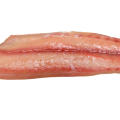

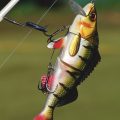
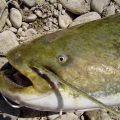







Pingback: Does Mahi Mahi have Scales? | Reel Fishing Guru
Pingback: Do Mahi Mahi have Scales? | Reel Fishing Guru